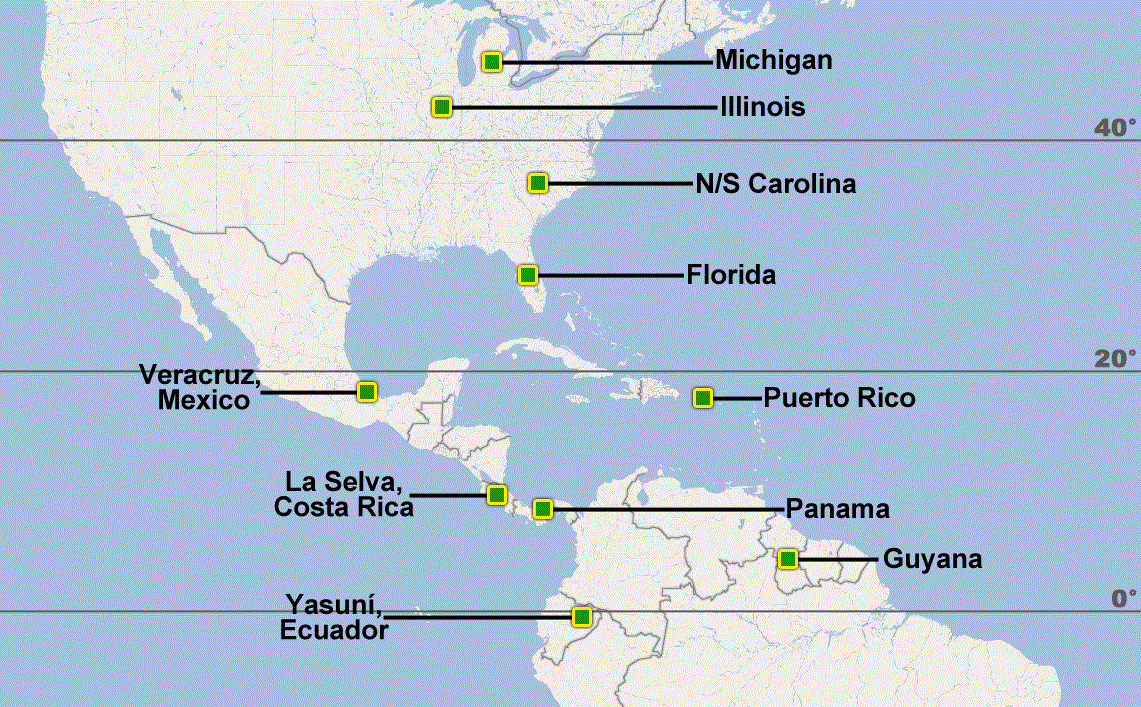Vine Dispersal Across Space (ViDAS) is research by Robyn Burnham, Colleen Smith, and Cristine Santanna from the 2011-2012 academic year. Part-time help was provided by Andrew Quebbemann, Lauren Sopher, and Marcos V. Santanna.
WHAT IS THE PROBLEM?
An unanticipated negative correlation was found between latitude and the proportion of wind- dispersed species among climbing plants (vines, lianas) at both local and regional levels. Vines and lianas are often animal dispersed (rather than wind dispersed) at high latitudes. This is opposite to the data on tree species, where wind dispersal is prevalent at high latitudes.
Because lianas use trees for structural support, lianas can invest less in carbon-rich support structures. Therefore, forests with a heavy liana load may store less carbon than a forest with a light liana load. Lianas spread over large distances using fruit and/or seed dispersal. This generates ecological diversity across a landscape, and bird-dispersed seeds in particular, can travel long distances in the guts of birds. In contrast, wind-dispersed seeds and fruits are most effectively dispersed when produced high in the canopy during dry weather, when their travel distance is maximized on wind currents. The mode of reproduction, as well as the species responsible for liana increase in an ecosystem, will guide management in forests under threat of liana infestation. Our research on dispersal modes across moist northern latitudes clarifies the role of sexual reproduction in liana increase across the northern hemisphere.
WHAT IS RESPONSIBLE FOR THE UNEXPECTED PATTERN?
We found strong correlations between Mean Annual Temperature (MAT), Mean Annual Range of Temperature (MART), Mean Annual Precipitation (MAP), and the proportion of wind-dispersed climber species in 45 floras along a latitudinal gradient from northern Michigan to Ecuador. No clear climatically-mediated selection seems to explain these correlations. We reason that any such selection should favor both trees and climbers.
Wind-dispersed climber species comprise up to 50% of the climber flora at low latitude sites (0-20° N) and less than 20% of the climber flora at latitudes > 25° N. Important plant families in species-rich, low-latitude, climber floras are Bignoniaceae, Apocynaceae, and Malpighiaceae, all of which are wind-dispersed. Most species in these families have xylem that is vulnerable to freezing temperatures and are rare at high, northern latitudes. In contrast, climbing families that dominate at high latitudes (e.g., Vitaceae) are bird and mammal dispersed and include species with xylem capable of withstanding freezing temperatures. These families are less diverse in tropical climber floras. We conclude that phylogenetic diversification is the source of the dispersal pattern, not ecological adaptation of the dispersal types to climatic parameters.




